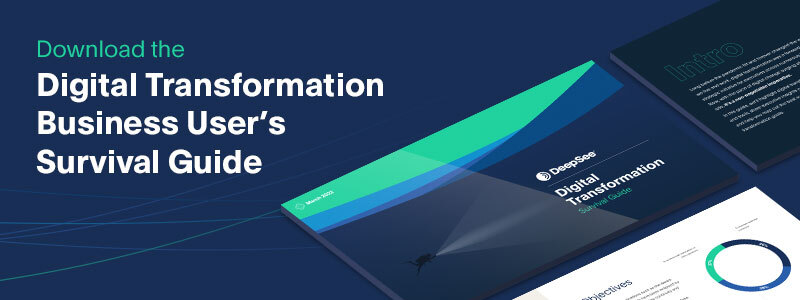How DeepRecon helps SMEs close the loop on the project lifecycle
Article
By Desi Silva
Talk of digital and business transformation is nothing new. But in recent years these terms have evolved from mere boardroom buzzwords to forward-looking strategies and core functions within the organization.
Companies with manual and time-intensive processes that rely on dated, legacy systems are particularly keen to transform their organization, and often look to intelligent process automation solutions to decrease human errors while increasing efficiencies.
Large financial institutions are especially eager and rightly so. Bogged down by manual and time-intensive processes that present ample opportunity for error, big banks must be extra vigilant, both in terms of their existing processes and when implementing new solutions. The smallest human error can cost millions in regulatory fines. In fact, six of the nation’s banks made recent headlines for a collective $1 billion in fines in just the last two years alone. A 20-year history of mistakes tallies up to 430 separate actions and nearly $200 billion in total fines and monetary sanctions, according to Better Markets May 2022 report.
Market volatility, pandemic-spurred shifts in consumer behavior, and the SEC’s looming settlement compression have only amplified the pressure on capital markets firms to digitally transform.
Many banks try to go at it alone, spending millions of dollars on internal systems that take years to build and many more to implement, if they ever manage to get off the ground. Others look to intelligent automation giants and RPA vendors that can’t understand their processes, require lengthy onboarding and programmatic training, and ultimately fail to add any real value long term.
How do I know the big banks are struggling with this? Because I spent 15 years working at one.
No RPA tool in the world could help me do my job better, because those tools are designed to be band-aid solutions for legacy systems and siloed teams. They require a user to string together a series of actions to complete a specific task. But that’s only half a human’s job.
When it comes to the project lifecycle, SMEs are required to identify and capture information, organize and interpret it, verify it, and then do something with it, like reconcile a trade. As they work to transform information into a specific outcome, they glean numerous insights.
These insights help them improve the customer experience, increase process efficiency and effectiveness, and identify new opportunities within the organization.
And yet all of this intelligence is lost when organizations rely on purported “AI-driven” automation platforms. That’s because these “intelligent” automation solutions focus on the first half of the project lifecycle, without closing the loop by incorporating knowledge management into the process.
When I found out what DeepSee was doing, I knew I had to be a part of it. As Director of Product Management for Capital Markets, I am helping the DeepSee team shepherd capital markets firms into the future with knowledge-driven process automation that empowers financial institutions to not only increase efficiency and reduce risk, but fundamentally make their processes and businesses better.
By delivering a platform that organizes for insight, DeepSee is able to parse through complex event-based data to give SMEs access to real-time, predictive and actionable insights that can help them understand what operational risk they’re carrying, or what their most profitable trade was and why.
Having experienced this firsthand during my tenure at one of the world’s largest banks, I know exactly what SMEs at financial institutions are struggling with. Outdated, legacy systems keep data and teams siloed, and because operations doesn’t own the information, and engineering has bigger problems to contend with, it takes days, even weeks to get what you need.
Isn’t that what RPA and other intelligent automation solutions are supposed to solve? The problem is that these so-called intelligent solutions only work for very specific scenarios, which means they fail to provide a long-term solution and require a lot of maintenance to maintain the status quo. So instead of managing five systems during my time at the bank, I was managing five systems and five bots.
With DeepSee it’s different. Built by subject matter experts like myself who have had long careers in large financial institutions, our platform and custom templates are designed with these specific problems in mind, and go further to close the project lifecycle loop, automating a subject matter expert’s ability to transform information into outcomes and access insights that can be implemented to continually improve the entire process.
Don’t believe me? Let me walk you through it. Reach out to schedule a time to discuss and let me show you firsthand how DeepSee is transforming capital markets.

